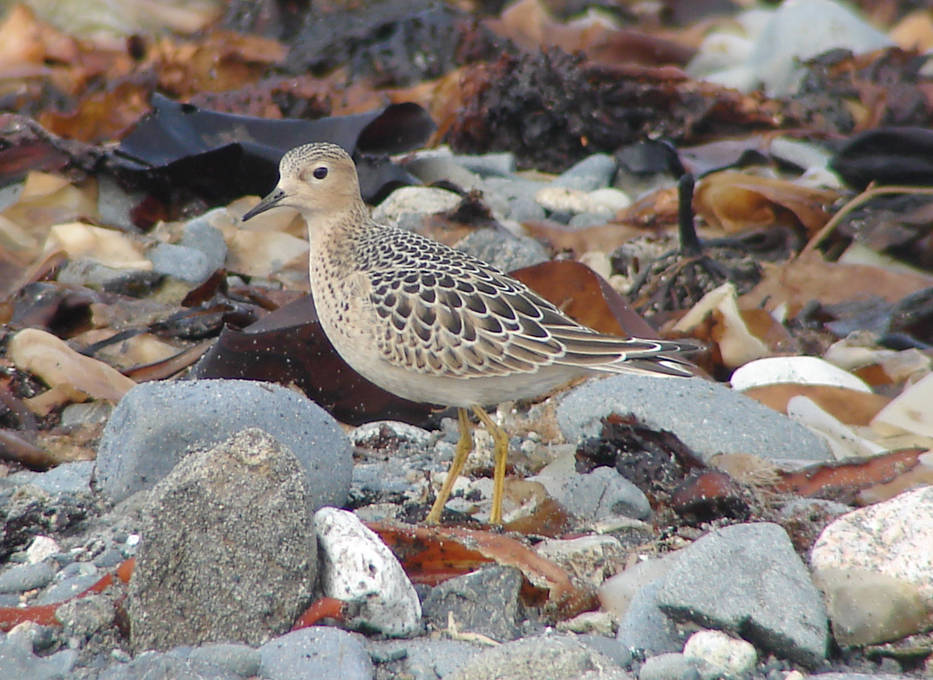Spring is a rough time for migratory birds, particularly for arctic nesting shorebirds and waterfowl. They’re busy making their way ever north to get to their breeding grounds. In our local area, hot spots to see birds are the Kenai River Flats, particularly waterfowl, and the Kasilof River Flats, where shorebirds tend to congregate.
Some pass through very early, like black brant, which often arrive on their breeding grounds when snow is still on the ground. Other geese and some ducks, such as mallards and northern pintails, also wing north in early spring, chasing the retreating snow line. Gadwalls and lesser scaup are among some of the last ducks to fly through.
Many shorebirds pass through early as beaches and estuaries are scraped free of snow and ice by tidal action. Many of the nondescript “peeps” — western, least and semipalmated sandpipers — stage along the way to ensure they don’t arrive too early or too late on the breeding grounds. Arrive too early, and that first nesting attempt might be wasted in a late winter storm. Arrive too late, and the best nest sites are already occupied and the opportunity is lost to raise their broods before ephemeral wetlands go dry later in the summer.
Whatever their migration chronology, most waterfowl and shorebirds need to feed along the way. Females, in particular, need to put on the body reserves that will allow them to produce eggs and to incubate for long periods. It’s often relatively easy to get close to birds during their spring feeding frenzies as they are more focused on eating than on you trying to do a little birding.
We love birds and we like to watch them, perhaps from Bridge Access Road or perhaps while walking our dogs along Cook Inlet beaches. And there’s the rub of it. Poor birding etiquette and other human behaviors can really stress birds, far more than you might expect.
As anybody who has ever dieted knows, your body weight is a function of energy expenditure (exercise) versus energy intake (food). Birds are no different. During spring migration, birds try to minimize their expenditure while maximizing their food intake so they can put on body fat, even while trying to maintain their muscle mass after long flights from the Lower 48 or perhaps Tierra del Fuego.
Anytime we disturb birds, accidentally or otherwise, we are negatively impacting that energy balance. Consider that a duck expends 10-12 times more energy in flight than it does at rest. In contrast, a walking or swimming duck expends only 1.4-1.8 times more energy than when at rest. So when we do disturb birds and make them flush, not only do they stop feeding, it also increases their energy expenditure several fold. Multiply this event by all the humans and dogs and ATVs that birds encounter during their long flight north, and you begin to understand the problem. This is a recipe for weight loss, not weight gain.
In the early 1990s, I studied the effects of recreational disturbance on sanderlings wintering at Assateague Island National Seashore off the coast of Maryland. Sanderlings disturbed by beachgoers or dogs or off-road vehicles spent 177 percent more time preening and stretching (agitated), 151 percent more time in flight, and 42 percent less time roosting than undisturbed sanderlings. These behavioral changes upped their energy expenditure by 50 percent, something you’d think sanderlings would try to avoid. Sure enough, population densities were 60 percent less on disturbed than undisturbed beach segments. These are not trivial impacts.
Here’s some tips if you want to make life a little easier on our feathered friends, especially if you’re a birder:
— Vehicles are usually less disturbing than people on foot, so view from your car with a window-mounted scope if the birds are nearby.
— Stop trying to take pictures with your smart phone. Invest in a decent camera with a long lens so you don’t have to approach too closely to get a good photograph.
— Like airplanes, birds like to launch into the wind. You’ll get a lot closer to birds without making them flush if you approach from downwind so their escape route isn’t cut off.
— Similarly, don’t ride a fat tire bike or ATV between feeding birds and water, as that makes them skittish and likely to flush.
— Birds see color, so wear neutral colors like browns and greens, and even camouflage, something all duck hunters know.
— Bring your dog to heel or leash it when you see a flock of peeps on the beach. Better yet, leave your dog at home.
Good birding etiquette isn’t something that’s just nice to do. It’s also smart to do if you make your living off wildlife viewing. Todd Eskelin, a Kenai Refuge biologist, was in Costa Rica recently. When something cool like a bananaquit or spiny green lizard was spotted along the trail during guided wildlife trips, his group chose to back away and use their scopes and binoculars to view the animal. It made life easier for the animal and allowed others following to have the same viewing opportunity.
We have two big birding festivals coming up on the Kenai Peninsula. The Kachemak Bay Shorebird Festival is May 10-13, and the Kenai Peninsula Birding Festival is May 17-20. Enjoy the birds, but give them the respect they deserve after their long flights.
Dr. John Morton is the supervisory biologist at Kenai National Wildlife Refuge. Find more information about the Refuge athttp://www.fws.gov/refuge/kenai/ or http://www.facebook.com/kenainationalwildliferefuge.

